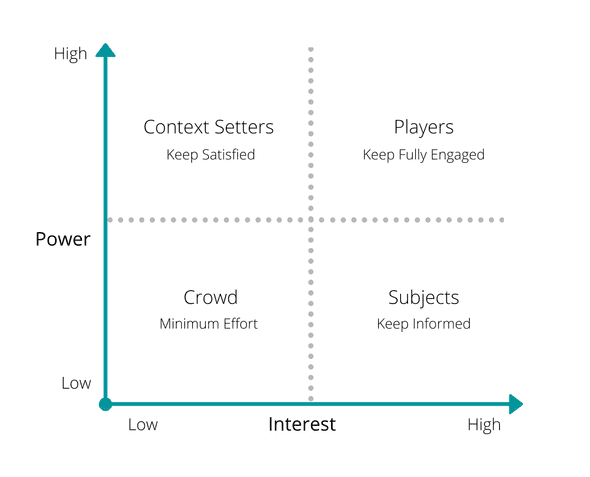Importance of Stakeholder Analysis
March 29, 2020
What is Stakeholder Analysis?
A Stakeholder Analysis is identifying people who will be involved in a project before it begins and grouping them on the basis of their levels of interest, participation, and influence in the project while determining how best to keep each of these stakeholders engaged throughout to make the project a success.
Why perform a Stakeholder Analysis?
- To identify key people to be informed about the project during the execution phase.
- Early alignment among all stakeholders on goals and plans.
- Understand and resolve potential risks and prevent misunderstandings.
- Opportunity for individuals to express their ideas/issues/concerns over the project.
How to perform a Stakeholder Analysis?
The way to perform a stakeholder analysis is fairly simple and can be done in three simple steps:
- Identify
- Prioritize
- Understand
Identify Stakeholders
First step is to identify all the stakeholders who might be people affected by the project, who have influence or power over it, or will be involved in making the project a success.
Stakeholders may be Investors, Advisors, Teammates etc.
Prioritize Stakeholders
Next, prioritize your stakeholders by assessing their level of influence, level of interest and level of involvement.
One popular way of doing this is by using the Power-Interest Grid where stakeholders are grouped into four categories:
-
Players [High Power, High Interest]
Keep them fully engaged and make the consistent efforts to keep them happy.
-
Context Setters [High Power, Low Interest]
Keep them up to date as they can have a lot of influence over the project but don’t wish to be actively involved in the details.
-
Subjects [Low Power, High Interest]
Keep them adequately informed and talk to them to ensure that no major issues arise. People in this category can offer great insights and ideas for the project.
-
Crowd [Low Power, Low Interest]
Monitor them with minimum effort and prevent excessive communication.
Understand Key Stakeholders
Once all that stakeholders have been identified and prioritized, we need to understand how they feel about the project and how to get support of each of these stakeholder types. We can achieve this by identifying answers to questions about your stakeholders such as:
- What motivates these stakeholders?
- Do they have financial or emotional interest in the success of the project?
- Is the interest positive or negative?
- What information about the project is relevant to them, and what is the best way to convey that information?
- Who influences the stakeholders opinions, and are those influencers also your stakeholders?
- If stakeholders are not likely to be supportive for the project, what can be done to win their support?
- If their support can’t be gained, what can be done to manage their opposition?
Conclusion
Projects may require participation, guidance, and approval from a wide range of stakeholders across the organization and if they are not aligned with the project’s goal and plan, any of these stakeholders may hinder the project’s success.
However, if we proactively identify all the stakeholders and get them on-board early on, we may transform these individuals into supporters. Therefore performing a stakeholder analysis before starting a complex company project is very useful to gain the support of relevant people and make the project a success.

